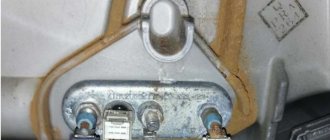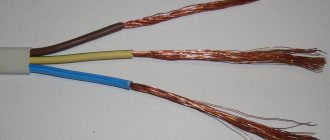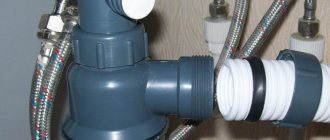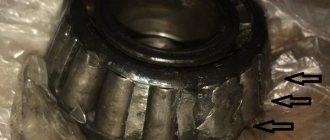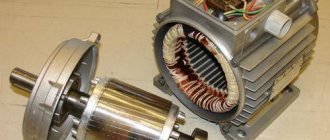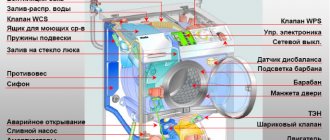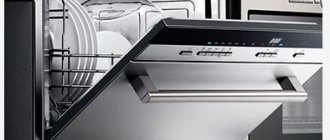A tubular heating element (TEN) is installed on all automatic washing machines to give the water a temperature in accordance with the selected mode. If it malfunctions, the quality of clothing care deteriorates: the laundry remains stale at the exit.
You can check the performance of the water heater by external signs of the washing process or using an electrical appliance. Having discovered a defect in the heating element, it is replaced with a new one.
- Determining the causes of heater failure
- Location of the water heater in the washing machine
- Methods for checking a tubular electric heater
- Heating element resistance measurement
- Procedure for replacing an electric heater
- Catalog of washing machines with reviews
Determining the causes of heater failure
The failure of a tubular element may not affect the machine’s performance of the specified washing mode, but for the vast majority of models, the autodiagnostic system is triggered. An alphanumeric code is displayed on the CMA display, informing about the corresponding malfunction, and the washing temporarily stops.
Pulling out the heating element
If there is no screen, a breakdown may be indicated by flashing or glowing LED indicators.
Signs of a heating element malfunction can be determined by the following circumstances:
- Long time heating of water. The temperature rises to +60ºС in no less than 5 minutes: the drum does not rotate for up to half an hour.
- Current leakage to the machine body. When you touch metal parts with your hand, a residual current device (RCD) is triggered: the light in the room where the SMA is located goes out.
- Traces of electric shock on the outer surface of the heater. To see the black dots, you will need to first clean the metal from the scale layer. A malfunction will be indicated by swellings and scratches on the tubular shell - these are places where the spiral located inside the cavity is likely to burn out.
- The speed of power consumption by the machine according to the apartment electricity meter. A consumption of 100 W in 3-5 minutes when heated to +90ºС will indicate the serviceability of the heating element.
- The loading hatch glass is cold. After a quarter of an hour of washing, the temperature does not rise.
- The condition of the laundry removed from the tank or drum. Particles of undissolved powder and an unpleasant smell of unwashed clothes are found on things.
The reasons for heater failure can be voltage drops in the electrical network, manufacturing defects, but more often the heating element fails due to poor water quality or improper operation of the washing machine.
The deposition of hardness salts on a tubular heater can be reduced by using pre-cleaning filters and regularly adding water softening reagents to the solution. Ignoring this factor leads to the growth of limescale on the surface of the heating element, its overheating and rapid wear of the coil.
Location of the water heater in the washing machine
The purpose of a large boiler is to raise the temperature of the water in the SMA tank to the desired hotness level. To achieve maximum heating effect, the heating element is located at the bottom of the washing machine.
For different models, access to the energy device is provided from the rear panel (Indesit, Ariston) or the front, like Bosch, Siemens. To understand where the heating element is located, proceed in the following sequence:
- Check the location under the rear wall of the case - it is easier to dismantle than the front panel. The heating element is determined by three terminals with wires extending from them.
- Tilt or place the car on its left or right side. If there is no bottom of the housing below, you can see the heater parts through the opening.
- Open the drum hatch and look through the holes in the perforated shell. With a flashlight, you can find the desired heating element.
Connecting an external heating element
Having understood which panel needs to be removed, they begin to dismantle it. When access to the heating device is provided, it is not necessary to immediately disassemble the circuit and remove the element: you can check the functionality on the spot.
Please take note
- When you install a new heating element or return the old one to its place, carefully ensure that all connections are absolutely tight. Make sure that the heating element is in the correct mount located at the bottom of the tank. Otherwise, the part will touch the drum during washing. Which, of course, will not have a very good effect on its future performance.
- Do not neglect preventive measures that will help extend the life of the heating element. Once every six months, run the wash in the standard cycle with an empty drum. Instead of washing powder, add a spoon or two of citric acid. This method will remove scale formed during operation. Read more about methods of dealing with scale on heating elements here.
Methods for checking a tubular electric heater
Instrumental diagnostics of the condition of the heating element begins with ensuring safe working conditions: the washing machine must be completely de-energized by disconnecting the CMA from the power outlet. The test can be carried out with a multimeter (tester), megohmmeter - they are equipped with their own batteries to supply a voltage of only a few volts, safe for humans.
The main ways to check the heating element for serviceability: ring the element for the integrity of the spiral, test its internal insulation for breakdown. In any case, access to the heater is necessary - dismantle the rear or front panel of the SMA. If you do not have a multimeter, contact a service technician.
How to check a heating element with a multimeter
It is imperative that all work to identify a malfunction must be carried out with the device disconnected from the power supply. Failure to do so may result in electric shock and personal injury. In order to test the heating element for operability, you need to know the nominal value of the electrical resistance (R) of a particular heater. It is easy to calculate using the elementary formula from Ohm's law. Knowing the value of the supply voltage (U) and the power consumed by the device from the network (P), using the formula R=U squared/P. For example, the device is powered from a 220 V network, its power is 1.5 kW (1500 W). Then the resistance of the heating element is 220 squared divided by 1500 and is 32.27 Ohms. For practical use, we take the value of the electrical resistance of the heating coil to be about 30-35 Ohms.
To check the heating element for integrity, we proceed in the following sequence. After making sure that the device is disconnected from the power supply, we disassemble it to gain free access to the heating element terminals, and disconnect them from the rest of the device, having previously marked the wires.
Marking will ensure correct connection during reassembly.
Having set the required resistance measurement range on the multimeter, we connect the probes to the heater contacts.
Tester readings in the area of the calculated figure (30-35 Ohms for the example given) clearly indicate the absence of a break or short circuit in the spiral. If the heating element is multi-contact, you need to check the integrity of each part of the spiral one by one, touching all the terminals in pairs.
Next, you need to make sure that the insulation of the tube filler has not been damaged during operation and measure it for breakdown. To do this, select the resistance measurement mode at the highest limit. Having installed one probe on the metal body, we touch all the heater terminals in turn with the second one.
If the device shows any resistance to the heating element, then there is a serious malfunction that requires replacing the heater. Further use may be hazardous to health.
How to check a water heater temperature sensor
The boiler is designed to have a thermal relay, a device that turns off the water heater when the water has heated to the desired temperature. After the water has cooled a little, the boiler switches on again for heating. You must first check the heating element to ensure that it is in good working order. Remove the thermostat from the boiler body and disconnect the wires. Having turned on the dialing mode or measuring the minimum resistance, we stand with one multimeter probe on any terminal, and with the second we touch the remaining one.
The device should indicate the presence of contact between the terminals.
To check the functionality of the regulator, you need to connect a multimeter to its contacts. After making sure that the device has a working circuit, lower the regulator rod into a container with very hot water. A click of the contacts and an open circuit on the multimeter will indicate the operation of the temperature sensor. When removed from hot water and cooled, the sensor should click again and the circuit will be restored, which will clearly indicate serviceability.
The water heater is powered from a 220 V network, therefore, as when checking the heating element tube, it is necessary to check the sensor for breakdown. To do this, check that there is no contact between any terminals and the metal elements securing the sensor to the body.
How to check the heating element of a washing machine
You can check the heating element and temperature sensor of the washing machine using the already described electrical testing methods, not forgetting about the mandatory disconnection of the 220 V voltage.
Having removed the wall of the machine behind which the heater is located, disconnect the wires and, if necessary, remove it from the body. To avoid mixing up the wires, first mark or photograph their original location. Then you need to check the heating element of the washing machine for the integrity of the spiral and the absence of breakdown using the appropriate measurement modes..
The temperature sensor of a washing machine, depending on the model, can be of different designs and have different testing methods.
Online diagnostics of a washing machine
If your machine stops washing or rinsing clothes normally, then some kind of malfunction or breakdown has occurred.
You can try to find the problem yourself. Run diagnostics
Select which operation your washing machine does not perform:
1. Doesn’t drain 2. Doesn’t rotate the drum 3. Doesn’t spin clothes 4. Noises, knocks, buzzes when spinning 5. Doesn’t turn on
Checking the operation of the drain pump Is the drain pump of the washing machine working? Yes No I don’t know << Back
Clogged hoses in the washing machine If the sound corresponds to the normal sound that has always been observed when the device is working, the cause is probably a clog.
Was there a blockage in the drain hose? Yes
<< Back
The drain pump does not work! If the sound matches the normal sound of the drain pump, it is recommended that you check the drain filter first.
After cleaning, does the drain pump work and does the washing machine drain water? Not really
<< Back
Operation of the drain pump The sound of the pump is usually immediately audible and noticeable. If there is no sound, the pump is not working. We are looking for how to separately enable the water drainage program. As a rule, this is a separate option. After the program has been turned on, the pump should start working in 1-3 seconds. If everything is done correctly and the pump is operational, a buzzing sound will appear. If you hear no buzzing or other sounds when you turn on the program, the pump is probably faulty.
Is the washing machine drain pump working? Not really
<< Back
Clogged car hoses If you have identified a clog in the hoses, you need to disassemble them, clean them, and then reassemble everything.
Does the washing machine drain well? Not really
<< Back
Hurray, you did a great job, you fixed it.
<< Return to the beginning of diagnostics
The drain pump is faulty, call a professional.
<< Return to the beginning of the diagnosis.
The washing machine does not rotate the drum. During the operation of the washing machine, such a problem may occur. Each model has a different drum operation. It rotates according to a given algorithm, which is set by the program. This principle applies to spinning and washing. If you are not sure whether the drum is not spinning or whether it is working, put the laundry in the washing machine. Start the spin program. If the machine is running, it will first drain the water and then start spinning. In this case, a rotational process will be observed. If rotation is not visible, then check the belt. First, turn off the program, then unplug the wire from the outlet so that power does not flow into the device. Now you need to remove the back cover. You will need to carefully inspect the drum belt. It is quite easy to determine whether it is in the wrong position or damaged.
Is the washing machine belt torn or stretched? Not really
<< Back
Broken drum drive belt If the belt breaks, it will be immediately visible. There are also often cases when the belt simply stretches, which is why the drum, accordingly, does not rotate. Do not allow the machine to operate if the belt breaks. It is important to check whether it has wound around the engine pulley or broken the wiring to the engine. The heating element and temperature sensor may also be damaged if the belt does catch the wires. It is imperative to ensure that the belt model is original. If you choose an unsuitable or low-quality product, this will affect the performance of other devices. How do you know what kind of belt you have? There will be a marking written on the old one, compare it with the one indicated on the belt offered to you. You can also find out belt information by car model.
<< Return to the beginning of the diagnosis.
Washing machine motor malfunction If a malfunction is not found, the block with wires must be disconnected from the electric motor. Carefully remove it. We visually evaluate the engine. It may have melting, cracks, or other effects that clearly indicate damage. We call the windings of the tachogenerator and the engine. It is important to understand that you can fully study how correctly the engine operates and whether there is a malfunction only at the stand. If rotation does not occur, there may be a problem with more than just the motor. Sometimes the cause is a malfunctioning electronic module. If a short circuit occurs in the engine, the module could be damaged, while the engine remains operational. Also, the wires could be damaged.
<< Return to the beginning of the diagnosis.
Repairing a washing machine that does not spin clothes After completing the washing process, the washing machine may not spin properly or may not start spinning. Firstly, look, perhaps another mode is set, which does not involve turning on the spin cycle at all. This happens, for example, with programs related to washing woolen items and delicate fabrics. To check, run the spin cycle separately. If the washing machine does not drain water, we proceed to check the pump.
Does the washing machine now spin clothes? Not really
<< Back
Congratulations, you have solved your problem!
<< Return to the beginning of the diagnosis.
Repair of washing machines, imbalance Modern washing machines place the laundry on the drum before spinning. This is necessary for quality work. Check if this feature works. Sometimes a situation occurs when things get wrapped up in a ball that cannot be unwound automatically within a certain time. At this point the work stops. You need to unwind this laundry yourself, lay it out and continue operating the washing machine. In this case, it is important to turn off the machine, and then, when the laundry is laid out, turn on a separate spin program.
Does the washing machine now spin clothes? Not really
<< Back
Washing machine repair, drum drive repair Now you need to check the drum drive belt. We remove the cover and visually assess the condition of the belt. There should be no damage. If the tension is weak, the spin may not turn on. If you need to replace the belt, you should only replace it with the original one. After replacing, we try the program again.
Fault found, does the washing machine spin? Not really
<< Back
The engine or electronic module is faulty, call a repairman to your home.
<< Return to the beginning of the diagnosis.
The washing machine hums, makes noise during the spin cycle, rumbles, and makes a jet plane noise. If the washing machine makes noise during operation, making unusual sounds, it’s time to pay special attention to it. In this case, a visible breakdown or lack of functionality may not be observed, but the appearance of strange sounds indicates that it is time to look for a malfunction. It is important to understand that a new car that has just been delivered should be inspected for shipping bolts. If you forget to remove them, noise and vibration are inevitable. So, let's begin! We turn the washing machine drum and listen to extraneous sounds.
When rotating, do you hear extraneous noise, hum, balls rolling, does the drum move unevenly with slight jamming? Not really
<< Back
If the drum rotates and uncharacteristic sounds appear, including vibration, it’s time to check the bearings. If they malfunction, they will have to be replaced.
<< Return to the beginning of the diagnosis.
The counterweight of the washing machine has come loose. The fastening of the counterweights must also be of high quality. If they are “loose”, it’s time to eliminate this defect. In some cases, you can notice that the bolts that secure the stones are completely missing. In this case, the connectors for mounting will be visible. The bolts need to be found and put in place - they probably simply came loose. A rumble heard while the washing machine is operating may indicate that the bolts have partially loosened. To check the bolts, you can simply push the drum. If it is secure, the bolts are fine. If it moves, there is a defect.
Do you hear any noise, clanging or rattling noises when moving the washing machine tub? Not really
<< Back
The counterweight has come off
<< Return to the beginning of diagnostics
Checking the shock absorbers of the washing machine Checking the shock absorbers. If you hear vibration or excessive noise during the spin cycle, there may be a problem with the shock absorbers. Sometimes the washer moves. Now let's check the functionality. Remove the top cover. Click on the tank, move it five to seven centimeters down. A normal reaction will be observed if the tank rises sharply, jumping a little and stopping in its normal place. If this does not happen, the shock absorbers need to be replaced.
Are the shock absorbers of the washing machine working? Not really
<< Back
If a visible defect has not been identified, check whether a foreign object may have entered the machine. Replacing shock absorbers. The problem with shock absorbers wearing out occurs quite often over time.
<< Return to the beginning of the diagnosis.
Replacing washing machine shock absorbers. Malfunction and wear of shock absorbers is a fairly common phenomenon.
<< Return to the beginning of the diagnosis.
The washing machine does not turn on. It is worth trying to find the cause of the problem yourself and fix it. We start by connecting the device to the network. Next, click on the “network” button. In different car models, different indications are triggered: here either the display will start working, or, on the contrary, some other button.
Does the washing machine have an indicator? Not really
<< Back
Hatch lock lock (UBL) You can check it by turning on any of the programs. We choose what we will use. Click on the corresponding button. Don't forget to pay attention to the inclusion. As a rule, the process of activating a function is characterized by the presence of a certain sound, for example a click, with which the device makes it clear that pressing again is not necessary and the machine is already working. If there is no sound, the button may be broken. In this case, the main thing that must be done is to block the hatch and start working. If this happens, everything is fine.
The washing machine is blocking the hatch and the UBL is triggered? Not really
<< Back
Water fill valve malfunction
<< Return to the beginning of the diagnosis.
The washing machine hatch does not lock
<< Return to the beginning of the diagnosis.
No indication Checking the electrical circuit. If you notice that the washing machine does not respond to being turned on, it is first recommended to check the power supply. The outlet may be faulty. Try connecting another device. If the outlet works, you need to check whether the circuit that conducts energy through the washing machine from one element to another is intact. To do this, you will need a multimeter, which will help you fully analyze the ability to respond to an electrical signal at several stages of operation. If there is no network connection anywhere, this is probably the problem. We carry out this manipulation until we reach the electronic module. If we are talking about an old washing machine, here it will look like the device’s program. When you turn on the button, there should be no breaks in the circuit. If the circuit works, everything is fine electrically.
Is the washing machine's power supply OK? Not really
<< Back
Repair of electronic module (unit)
<< Return to the beginning of diagnostics
Contact circuit fault
<< Return to the beginning of diagnostics
Ringing a power consuming device
To check the integrity of the spiral inside the heating element, the supply wires are disconnected from the element. Before doing this, it is useful to note the order of connection to the terminals and capture the initial appearance in the photo. It is not necessary to remove the heater from the tank.
Multimeter
Tester test sequence:
- Set the switch to test resistance: up to 200 Ohms. Checking the serviceability of the multimeter - close the lead wires of the meter: zero will be displayed on the screen. Attach the probes of the device to the contacts.
- The normal range of scale readings is 20-50 Ohms. The boiler is in working order.
- Values ≥100 indicate a heater failure.
- Infinity is a break in the spiral. Zero – short circuit.
Expert opinion
I work in the household appliance repair industry. Extensive experience in restoring washing machines and dishwashers.
Ask a Question
Any deviations from the standard values of the coil resistance entail the need to replace the electric heater with a new one. Testing the element on the body should give a result close to infinity. If the device resistance is significantly less than 20 ohms, the heater is faulty.
Checking for breakdown
The space between the spiral and the inner walls of the tube is filled with dielectric powder made of mica, heat-resistant clay or quartz. Such an insulator protects the heater shell from contact with the spiral through which the electric current passes.
A breakdown test is carried out when electricity leaks occur in the washing machine on the metal parts of the body, and the RCD is triggered. Actions to determine a breakdown:
- The tester switches to buzzer mode. Checking the serviceability of the measuring device is carried out by shorting the output wires. At the same time, a light signal from the light bulb will appear and a sound will sound - a squeak. One probe is placed on any terminal of the heater, the other touches the metal shell of the heating element or the grounding contact.
- The absence of a signal sound will indicate that the element is working properly. Further operation of the boiler is permitted.
- A buzzer squeaking during a breakdown test is a sure sign of a breakdown of the electric heater.
Long-term use of a washing machine leads to physical aging of its parts, including the insulation inside the heater. Observe the decrease in the quality of the dielectric powder using a megohmmeter.
New water heater
Checking the current leakage of the heating element
First of all, the search for the cause of the malfunction must begin with checking for current leakage.
Usually, if this happens, immediately when connected to the network, the RCD or differential switch is triggered and the line is de-energized. The leak search is performed as follows:
1. Unplug the electrical appliance being tested from the outlet;
2. We disassemble it to gain access to the electric heater terminals;
3. Turn on the dial mode on the multimeter and insert the probes into the “COM” and “VMa” connectors;
4. We first ring one contact on the device body, then the other;
5. Possible results:
— There is a signal , the indicator on the display is close to “0” - the heating element is faulty;
— No signal , “1” on the display – no leakage;
Unfortunately, by calling in this way, you will not always be able to detect a breakdown. Quite often, this is detected only by a specialized tester - a megohmmeter, which tests circuits with high voltage. Minor insulation damage is detected only in this way. The multimeter will only detect obvious defects, for example, when the phase conductor touches the neutral conductor.
Often, a leak can be detected by measuring the heating element when it is turned on. But I don’t recommend doing this unless you are 100% confident in your electrical skills.
If you find a leak , a connection between one of the contacts and the housing, you need to look for the location of the breakdown. I advise you to disconnect the power wires from the electric heater and take measurements without them. Then you will understand whether the heating element or other elements of the power circuit are to blame.
If the problem is not found, we continue diagnostics:
Heating element resistance measurement
The condition of the boiler can be assessed by comparing the actual values of the quantities with the standard figures obtained by calculations. To see how different the calculated electrical characteristics are from the indicators actually determined using a multimeter, knowledge from a school physics course is sufficient. To carry out the calculations you will need the following initial data:
- voltage in the socket for SMA – 220 V;
- washing machine heater power - the figure is taken from the technical data sheet of the household appliance;
- formula for calculating resistance: the ratio of the mains voltage to the second power to the rated power of the heating element.
Expert opinion
I work in the household appliance repair industry. Extensive experience in restoring washing machines and dishwashers.
Ask a Question
Calculations for a 1.8 kW heater: 220²/1800=26.8. Boiler 2000 W: 220²/2000=24.2. The dimension of the result in both examples is Ohm, which is the standard resistance value for heating elements of different powers. Such numbers on the screen of the measuring device confirm the serviceability of each of the heaters.
Procedure for replacing an electric heater
Having made sure that the heating element does not work, they begin to dismantle it. During the disassembly process, it is recommended to photograph the main stages - this will make it easier to return the new heater to its original place. The procedure for replacing a burnt heating element is as follows:
- Unscrew the fastening nut - it is located in the center of the block and attracts the grounding wire.
- Press the released bolt inward, which passes through the rubber plug and rests its head against the pressure plate. In a compressed state, this design ensures the tightness of the tank at the point where the heating element enters it. When the bolt is released, the plug returns to its original shape, coinciding with the contour of the seat.
- Use a knife or screwdriver to carefully pry up the heating element so as not to damage the tank. Remove the heating element to replace it with a new one. Limescale deposits and rust complicate dismantling - you need to pull out the tubular structure one by one from each side, moving a fraction of a millimeter.
- Installing a new heating element is not difficult: the rubber retainer of the heater easily fits into the socket, where it is clamped with a fastening nut. Excessive force is inappropriate here - you cannot squeeze the sealant or break the thread.
Do you turn off the water tap after washing?
Oh yes! No.
Upon completion of the heater change, the CMA tank is checked for water leakage through the installation socket. After this, the power wires and grounding are connected. The previously removed panel is installed in its original place, the machine is connected to the electrical network and other communications, and a test run of the washing mode is performed.
You should not delay checking the serviceability of the water heater: a breakdown can develop into a major accident, which will entail the need for expensive repairs. Self-diagnosis is available to many home craftsmen, and the information provided here will help you replace a faulty heating element.
